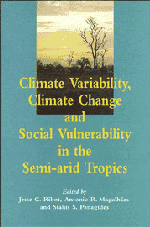Book contents
- Frontmatter
- Contents
- List of contributors
- Foreword by Tom Downing
- Preface
- List of abbreviations
- Introduction. Climate Variability, Climate Change and Vulnerability: Moving Forward by Looking Back
- PART I OVERVIEW
- PART II CLIMATE VARIATION, CLIMATE CHANGE AND SOCIETY
- PART III CLIMATE VARIABILITY AND VULNERABILITY: CAUSALITY AND RESPONSE
- PART IV THE INTERNATIONAL CONFERENCE ON THE IMPACTS OF CLIMATIC VARIATIONS AND SUSTAINABLE DEVELOPMENT IN SEMI-ARID REGIONS (ICID)
Introduction. Climate Variability, Climate Change and Vulnerability: Moving Forward by Looking Back
Published online by Cambridge University Press: 02 December 2009
- Frontmatter
- Contents
- List of contributors
- Foreword by Tom Downing
- Preface
- List of abbreviations
- Introduction. Climate Variability, Climate Change and Vulnerability: Moving Forward by Looking Back
- PART I OVERVIEW
- PART II CLIMATE VARIATION, CLIMATE CHANGE AND SOCIETY
- PART III CLIMATE VARIABILITY AND VULNERABILITY: CAUSALITY AND RESPONSE
- PART IV THE INTERNATIONAL CONFERENCE ON THE IMPACTS OF CLIMATIC VARIATIONS AND SUSTAINABLE DEVELOPMENT IN SEMI-ARID REGIONS (ICID)
Summary
… Somos muitos Severinos
iguais em tudo e na sina:
a de abrandar estas pedras
suando-se muito em cima,
a de tentar despertar
terra sempre mais extinta,
a de querer arrancar
algum roçado da cinza.
Mas, para que me conheçam
melhor Vossas Senhorias
e melhor possam seguir
a historia de minha vida,
passo a ser o Severino
que em vossa presença emigra.
João Cabral de Melo Neto, Morte é Vida Severina, 1966Severina is a common name in the dry Northeast of Brazil – it is a name akin to the word for severity, reflecting rural life in these drylands. The experience of severe deprivation is widespread in the semi-arid tropics. Indeed, there are many Severinos living lives of constant vulnerability to hunger, famine, dislocation and material loss. Extreme climatic events, such as droughts, simply unveil this underlying chronic state. Such vulnerability is not caused by climate variability or climate change alone (Sen 1981; Watts 1983a). It is a result of the configuration of forces that shape the ability of farm and pastoral populations to produce, reproduce and develop. Climate extremes are an expected characteristic of semi-arid lands. Most populations know from local history the frequency and likely consequences of extreme climatic events. And most populations in highly variable or extreme climatic zones shape their livelihood systems to buffer against potential catastrophes. They prepare with the means at their disposal for these expected, yet unpredictable, threats.
- Type
- Chapter
- Information
- Publisher: Cambridge University PressPrint publication year: 1996
- 11
- Cited by



